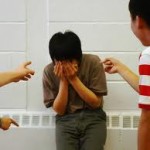By Bernice Yeung
 Schools and prosecutors are grappling with the legal issues raised when harassment over the Internet leads to suicide.
Schools and prosecutors are grappling with the legal issues raised when harassment over the Internet leads to suicide.
Earlier this month, a 14-year old boy from Middleburg, Pennsylvania threw himself in front of a tractor-trailer after leaving a suicide note that said he was tired of being called a “faggot” and a “sissy” at school.
It was the latest in a string of teen suicides tied to bullying. In September, Rutgers University freshman Tyler Clementi threw himself off the George Washington Bridge after his roommate, Dharun Ravi, and a woman who lived down the hall named Molly Wei, secretly recorded Clementi having sex and then broadcast the footage online. In January, a Massachusetts high school student named Phoebe Prince took her own life following persistent bullying by schoolmates. And in September 2009, 13-year-old Hope Witsell of Florida committed suicide after her topless photo was circulated around her school via text message.
The phenomenon has already earned its own catch-all name in the media and among researchers: “bullycide.”
Although those who have been bullied contemplate suicide at a higher rate―and between 10 percent and 40 percent of American students report being bullied at school, according to the Cyberbullying Research Center―observers say the problem is becoming exacerbated by the Internet, which can quickly turn face-to-face harassment into a viral assault in cyberspace that exacerbates the pain and embarrassment suffered by the targets.
Cyberbullying, as it is called, has triggered a fervent debate in schools, in the courts and in state legislatures over the best way to address the behavior. As a legal matter, these cases exist within a confounding mix of emerging technology, free speech rights, criminal law and politics—all of which has experts scratching their heads.
The prosecutors’ dilemma
Going after cyberbullying isn’t an open-and-shut case. There is no agreed-upon definition for the term, and although behavior and activity associated with bullying and cyberbullying can become criminal acts, the words “bullying” or “cyberbullying” appear in very few state criminal statutes. (And states like Louisiana, which explicitly criminalized cyberbullying earlier this year, has been criticized by legal observers for enacting an unconstitutional law that violates the First Amendment.)
As a result, prosecutors have relied on existing criminal statutes, including stalking or harassment. Most states have begun to incorporate language about the use of smart devices and social media into existing stalking or harassment laws, but these laws run the gamut, says Suzanna Tiapula, director of the National District Attorneys Association’s National Center for Prosecution of Child Abuse. “Some of these statutes have not been tested. There is a desperate need to respond appropriately, so states are trying to craft solutions. But they are relatively new and there are a range of responses to trying to protect children and adults.”
In the Prince case, where classmates reportedly called the recent Irish immigrant lewd names and threw a can at her head, local efforts to pursue justice focused on prosecuting six students at her school who allegedly led the verbal assault. The indicted students face criminal charges ranging from stalking and harassment to violating Prince’s civil rights, leading to injury. At least three of the teens are slated to go to trial in early 2011. Local prosecutor Elizabeth Scheibel filed charges based on anti-stalking and civil rights statutes, some of which legal analysts say are an uphill battle. (District Attorney Scheibel did not return calls seeking comment.)
In the Rutgers case, Ravi and Wei have been charged with numerous counts of invasion of privacy, and a criminal investigation is ongoing in the case. Prosecutors in Middlesex County, which is handling the case, even hesitate to call the Rutgers incident a cyberbullying case.
“We are not framing it that way,” says Jim O’Neill, the spokesperson for the Middlesex County Prosecutor’s Office. O’Neill says that no court dates have been set, and that the prosecutor’s office is “looking into a variety of potential charges,” including a hate crime, because Clementi was taped having intercourse with another man.
Charges such as the violation of civil rights leading to injury in the Prince case, or the manslaughter charges that some advocates are pushing for in the Rutgers case, may be difficult to prove.
“There is always the problem of causation, which is the underlying principle of every criminal charge,” observes Patrick Corbett, a criminal law professor at Cooley Law School in Lansing, Michigan. “The question is: was the defendant’s action what caused the suicide? It’s not an easy case for the prosecutor to work with.”
Experts note that suicides, in particular, are difficult to pin to one specific cause. “I don’t think you can say that there is a direct cause and effect between being bullied and making the decision to commit suicide,” says Susan Swearer, an educational psychology professor at the University of Nebraska-Lincoln who specializes in bully intervention. “Bullying is a factor in the suicide, so there are lots of questions in these cases.”
Indeed, criminal prosecutions don’t always lead to convictions. Most famous, perhaps, is the case against Lori Drew , a Missouri mother who hired a teenager to create a fake My Space profile and posed as a 16-year-old boy in order to spy on one of her daughter’s former friends, Megan Meier, because Drew feared her daughter was being badmouthed by the teen.
Using the false identity, Drew sent Meier a number of messages through My Space, including one that read, “The world would be a better place without you.” That message, according to prosecutors, tipped the 13-year-old Meier over the edge. She killed herself in 2006.
Prosecutors admitted to reporters at the time that they did not have enough evidence to pursue stalking or harassment charges, and an attempt to criminally charge Drew under the Computer Fraud and Abuse Act eventually led to an acquittal.
Determining ‘intent’
Criminal prosecution in some bullying cases is particularly challenging because in addition to causation, the prosecution must also show intent, and some incidents that have been dubbed “cyberbullying” may not meet the standard.
“What is important here is not how the victim feels, but what the putative offender knew or intended,” says Franklin Zimring, a professor at UC Berkeley School of Law. “This is to protect civil rights—it must be behavior such that the person committing it knows is extreme. We need to set the bar high for criminal liability.”
When it comes to more serious criminal charges, like murder or manslaughter charges that have been called for in some bullycide cases, “you either had to be negligent or intended the harm before you can be criminally liable for it,” Zimring says.. “If you’re saying that hurt feelings and deception were intended [through the bullying], well, hurt feelings and deception are two dishes often served during adolescence, and sometimes the scope of cyberspace makes things worse, but I’m not sure that’s going on a lot [in terms of the law].”
But Zimring says he understands why district attorneys choose what is perhaps a difficult legal path. “It’s great publicity for the prosecutor and it ‘sends a message,’” he acknowledges. “And it is a symbolic vindication of the victim and of the family’s loss.”
Despite the challenges in criminal court, we may begin to see more prosecutions in bullycide cases, as law enforcement and prosecutors become more attuned to them, says Scott Burns of the National District Attorneys Association, who adds that his members do not feel “a reluctance to prosecute these cases.”
Wendy Murphy, a law professor at New England School of Law in Boston, startled some audience members at a symposium on cyberbullying in October when she told prosecutors to “grow a pair” by prosecuting bullies.
“Prosecutors bring one case once against a bully and people pay attention,” she told The Crime Report later. “It makes a difference. This is not to beat up the bullies, but I think we should respect life enough to be able to say to the bully that if someone kills themselves, you bear the burden. That one consequence is criminal prosecution.”
Naturally, not everyone agrees.
“Bullying prevention is a wonderful idea, and criminal law is a terrible tool for it,” argues UC Berkeley’s Zimring.
According to research by Swearer, the education psychologist, bullies themselves often experience higher rates of social anxiety and depression. “It’s important to look at intervention, not just at throwing the book at these kids,” she says. “There’s got to be a consequence. We’re not taking the time to figure out why someone is doing this, and helping them to see that this is not okay.”
Are schools liable?
Schools can be challenged in court for bullycides, too. But these cases raise another set of legal questions: Where to draw the line between what’s free speech and what’s unacceptable bullying?
Schools and courts have typically relied on the decision in the 1969 U.S. Supreme Court case Tinker v. Des Moines Independent Community School District, a case that focused on the rights of Iowa students to wear black armbands to protest the Vietnam War. The Court ultimately held that in order for a school to intervene, the student speech must “materially and substantially interfere” with the operations of the school or it must “impinge upon the rights of others.”
With some cyberbullying taking place off campus, it’s less clear how educators should interpret Tinker.
“What a kid types in their bedroom, the school has no legal control over,” says Daniel Weddle, a law professor at the University of Missouri-Kansas City who studies bullying. “There is a nexus [between the school and the off-campus speech], but it’s not clear where the nexus should be. The courts are really struggling with this question.”
Those struggles are less acute in the Rutgers case. “There is much less control in higher education because we’re dealing with legal adults,” Weddle says. “In terms of liability, it’s harder to get universities on the hook for not intervening.”
Some courts say that if it’s “foreseeable” that the speech would create a material and substantial disruption during the school day, then the school has the right to step in.
Meanwhile, Weddle notes that other courts have said that even if the questionable speech reaches the schoolhouse door, educators don’t necessarily have jurisdiction over it. (Educators and attorneys are watching two Pennsylvania cases to gauge where to draw that line. A Third Circuit court decision on both is pending.)
“We see administrators who are really unsure about how far their disciplinary arm can reach,” notes Kathleen Conn, author of The Internet and the Law: What Educators Need to Know . “The First Amendment doesn’t protect true threats, but what is a true threat? It’s a legal term of art that varies in its interpretation from circuit to circuit.”
In cases where the target’s family has tried to take schools to court, the schools have typically settled or won.
“Normally, you don’t hold one person liable for the actions of another person,” explains Weddle of the University of Missouri-Kansas City. “So to hold schools liable for the acts of its students, you have to show that the school could control the action, and its failure to control the action was the proximate cause of the injury.”
The White House steps in
In late October, the U.S. Department of Education, jumped into the fray, with an assist from President Barack Obama. The department issued an “advisory” on bullying that was intended to provide guidance on identifying and reporting harassment.
“We have an obligation to ensure that our schools are safe for all of our kids,” Obama said in a statement following the late October release of the advisory. “Every single young person deserves the opportunity to learn and grow and achieve their potential, without having to worry about the constant threat of harassment.”
But critics say that the advisory is just that—advice.
“Advisories are as low as one can go—I’d liken them to op-eds, frankly,” argues New England Law School’s Murphy, “[They are] published sentiments using moral suasion to change behavior.”
In that regard, the Department of Education advisory isn’t too different from state anti-bullying legislation. Currently, 43 states have anti-bullying statutes, according to the Cyberbullying Research Center, but these laws only provide guidance and regulate schools and public libraries.
These laws—most of which came online in the past year or so—feature a mix of measures, ranging from the creation of prevention and intervention programs at schools to mandates requiring specific anti-bullying policies and the reporting of incidents to the school administration or law enforcement.
Such laws are “much ado about nothing,” claims Weddle. “They often require nothing more than a policy that says bullying is bad, but sidestep training and any attempt to change the culture of the school.” The other problem with the statutes, Weddle says, is that they often don’t provide a way for parents or students to take schools or districts to court if the anti-bullying laws aren’t being followed.
The Massachusetts anti-bullying law was enacted in May in response to the Phoebe Prince case, and it requires that each school create a bullying prevention and intervention plan. It has been praised by prosecutors and law enforcement for clearly defining the term “cyberbullying,” and for raising awareness of the issue.
Though it, too, does not provide an avenue for individuals to hold the schools or districts accountable in court, it does create a special commission that will investigate the possibility of imposing criminal and civil liability on parents of bullies.
Federal laws, such as the Safe Schools Improvement Act, are not necessarily any more effective, according to Kathleen Conn, who is also a law professor at Neumann University in Ashton, Pennsylvania.
“These federal laws go into vacuum,” she says. “They never reach down to individuals. You can pass all of the anti-bullying laws you want at a federal level, but if you don’t disseminate and you don’t fund them and if you don’t monitor effectiveness, then why waste the paper?”
The role of civil rights
Ultimately, the New England Law School’s Wendy Murphy, who calls herself a child advocate, says the problems that schools and courts have had in locating bullying’s proper place in the criminal and civil law has to do with the current refusal to acknowledge the underlying civil rights issues at play.
“We need to deal head-on with the nature of this problem as a civil rights issue,” she says. “We are framing what is historically known as targeted civil rights harassment. We have policies, procedures, and a long history in the law of dealing with bullying, as long as we call it what it is, which is harassment.”
She continues: “If a child is targeted, and if it is sex-based and gendered, as most cases involving suicide, if you call it bullying, you’ll get a tort response. But if you go to the school and call it a Title IX problem, a sexual harassment problem, or harassment because of sexuality, and you frame it that way, it will prompt an effective response.”
For Phoebe Prince, the lesson has come too late.
If her parents had taken the issue to court on the grounds of sexual harassment, Murphy suggests, Prince “would still be alive.”
Bernice Yeung is a freelance journalist based in San Francisco.
 My son has a cleft lip, and other kids have been making fun of him. How can I help him handle the teasing?
My son has a cleft lip, and other kids have been making fun of him. How can I help him handle the teasing?















